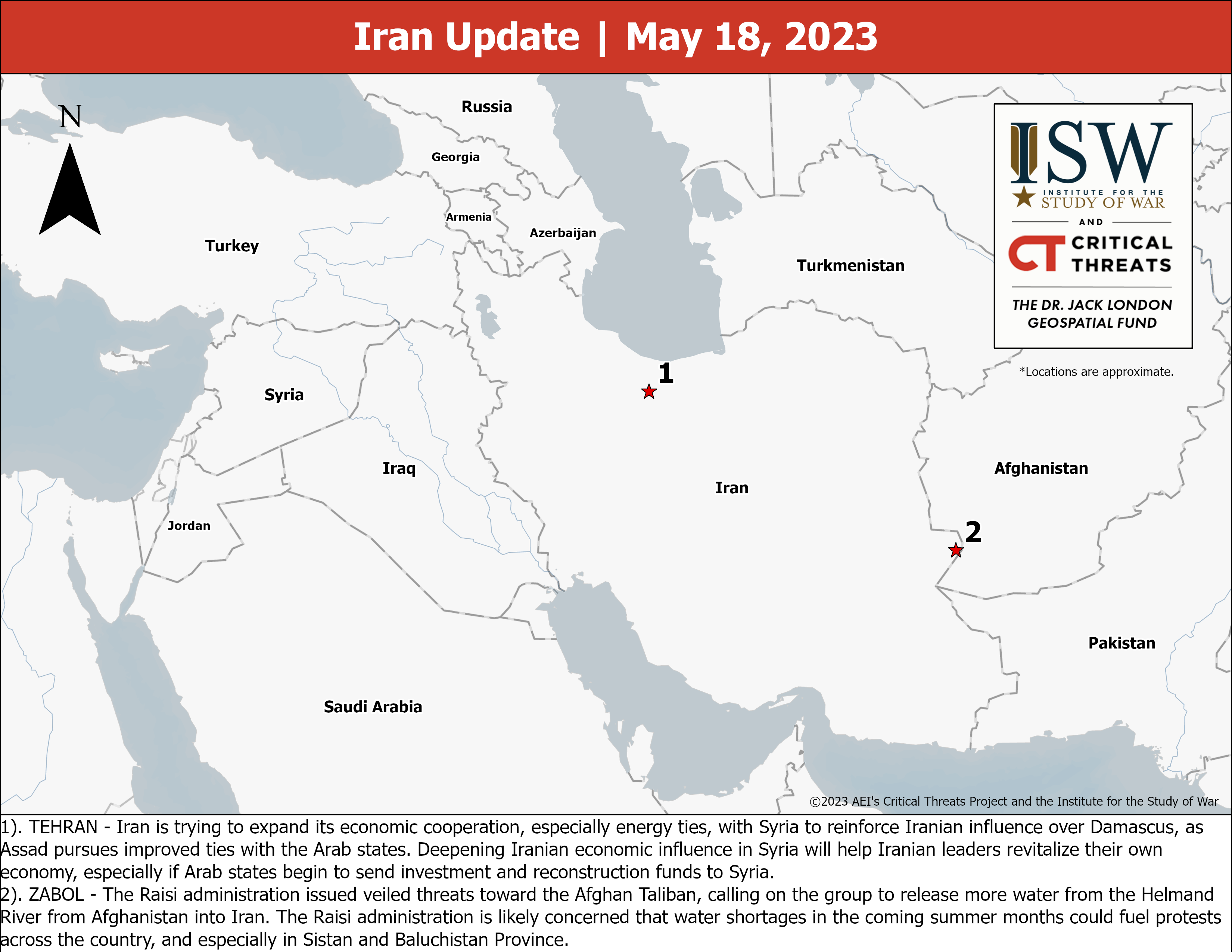 |
 |
Iran Update, May 18, 2023
Iran Update, May 18, 2023
Andie Parry, Johanna Moore, Annika Ganzeveld, and Nicholas Carl
The Iran Update aims to inform national security policy by providing timely, relevant, and independent open-source analysis of developments pertaining to Iran and its Axis of Resistance. This update covers political, military, and economic events and trends that affect the stability and decision-making of the Iranian regime. It also provides insights into Iranian and Iranian-sponsored activities abroad that undermine regional stability and threaten US forces and interests. The Critical Threats Project (CTP) at the American Enterprise Institute with support from the Institute for the Study of War (ISW) provides these updates Monday through Friday. To receive Iran Updates via email, please subscribe here.
Key Takeaways
- Iran is trying to expand its economic cooperation, especially energy ties, with Syria to reinforce Iranian influence over Damascus, as Assad pursues improved ties with the Arab states. Deepening Iranian economic influence in Syria will help Iranian leaders revitalize their own economy, especially if Arab states begin to send investment and reconstruction funds to Syria.
- The Raisi administration issued veiled threats toward the Afghan Taliban, calling on the group to release more water from the Helmand River from Afghanistan into Iran. The Raisi administration is likely concerned that water shortages in the coming summer could fuel protests across the country, especially in Sistan and Baluchistan Province.
Iranian Activities in the Levant
This section covers Iranian efforts to consolidate and expand Tehran’s economic, military, and political influence throughout the Levant and especially in Syria. This section examines some of the many campaigns that Iran is pursuing to achieve this strategic objective. CTP will update and refine our assessments of these campaigns over time and in future updates.
Iran is trying to expand its economic cooperation, especially energy ties, with Syria to reinforce Iranian influence over Damascus ahead of Arab-Syria normalization. Iranian Oil Minister Javad Owji met his Syrian counterpart, Firas Kaddour, in Tehran on May 18 to discuss implementing the energy agreements that presidents Ebrahim Raisi and Bashar al-Assad signed in Damascus on May 3.[1] Raisi and Assad also signed agreements relating to reconstruction, telecommunications, and transportation at the time.[2] The contents of the energy agreements are unclear, although Iranian state media has described them as a “road map” to deepen cooperation.[3] The agreements could pertain to Syria paying its debt to Iran, which derives partly from Iranian oil sales to Syria. Iranian officials have claimed that Syria owes Iran around $30 billion.[4] The agreements could also pertain to resuming contracts for Iran to rehabilitate two power plants in Aleppo and Hama provinces. Iran reportedly canceled the contracts after Assad tried to pay in raw phosphate.[5]
Iranian leaders are trying to reinforce their influence over Damascus—both economically and militarily—as Assad pursues improved ties with the Arab states. Assad traveled to Saudi Arabia on May 18 for the first time since the Syrian civil war began in 2011 and will attend an Arab League summit on May 19.[6] These events mark significant, albeit symbolic, steps toward Assad normalizing his diplomatic relations with the Arab states. Assad will also reportedly meet with Saudi Crown Province Mohammed bin Salman and Emirati President Mohammed bin Zayed during the visit to secure reconstruction funding.[7] Iran meanwhile began constructing a military base in southern Damascus on May 17 to entrench its long-term presence in Syria, as CTP previously reported.[8]
Deepening Iranian economic influence in Syria will help Iranian leaders revitalize their own economy, especially if Arab states begin to send investment and reconstruction funds to Syria. An influx of cash and financial resources into Syria will create opportunities for Iran to circumvent sanctions and leech funds from the Syrian economy. Such circumstances would also empower Iran to send more funds to its proxy and partner militias throughout Syria, further reinforcing its military presence.
Iranian Domestic Affairs
This section covers factors and trends affecting regime decision-making and stability. CTP will cover domestic politics, significant protest activity, and related issues here.
The Raisi administration issued veiled threats toward the Afghan Taliban, calling on the group to release more water from the Helmand River from Afghanistan into Iran. President Ebrahim Raisi visited southeastern Sistan and Baluchistan Province on May 18 and stated that Iran will not allow any country to deprive its people of their water rights. Raisi added that the Afghan Taliban should take his warnings about water seriously and “not complain later” that it was unaware of Iran’s demands.[9] Foreign Affairs Minister Hossein Amir Abdollahian separately warned on May 18 that the regime will use ”pressure tools” if the Afghan Taliban does not provide Iran with water.[10] These statements follow Iranian Ambassador to Afghanistan Hassan Kazemi Ghomi’s claim on May 15 that Afghanistan only provided Iran with 4 percent of its promised water supply between March 2022-2023, citing a 1973 water treaty.[11]
The Raisi administration is likely concerned that water shortages in the coming summer months could fuel protests across the country, and especially in Sistan and Baluchistan Province. Many Sistan and Baluchistan Province residents rely on agriculture to make a living and some residents protested water scarcity on April 24.[12] Sistan and Baluchistan Province is additionally a historically restive region that is home to a large Sunni Baloch population. Zahedan, Sistan and Baluchistan Province residents have organized weekly demonstrations since September 2022 to protest regime violence and discrimination against Balochis. The Afghan Taliban may struggle to acquiesce in Iran’s demands, however, as Afghanistan faces its third consecutive year of drought.[13]
[1] https://www.irna dot ir/news/85114987
[3] https://www.irna dot ir/news/85114987
[4] https://tejaratnews dot com/%D8%B3%D9%81%D8%B1-%D8%A7%D8%A8%D8%B1%D8%A7%D9%87%DB%8C%D9%85-%D8%B1%D8%A6%DB%8C%D8%B3%DB%8C-%D8%A8%D9%87-%D8%B3%D9%88%D8%B1%DB%8C%D9%87-1402
[7] https://tass dot ru/mezhdunarodnaya-panorama/17760285 ; https://sana dot sy/?p=1896203
[9] https://president dot ir/fa/144038
[11] https://www.entekhab dot ir/fa/news/726316
